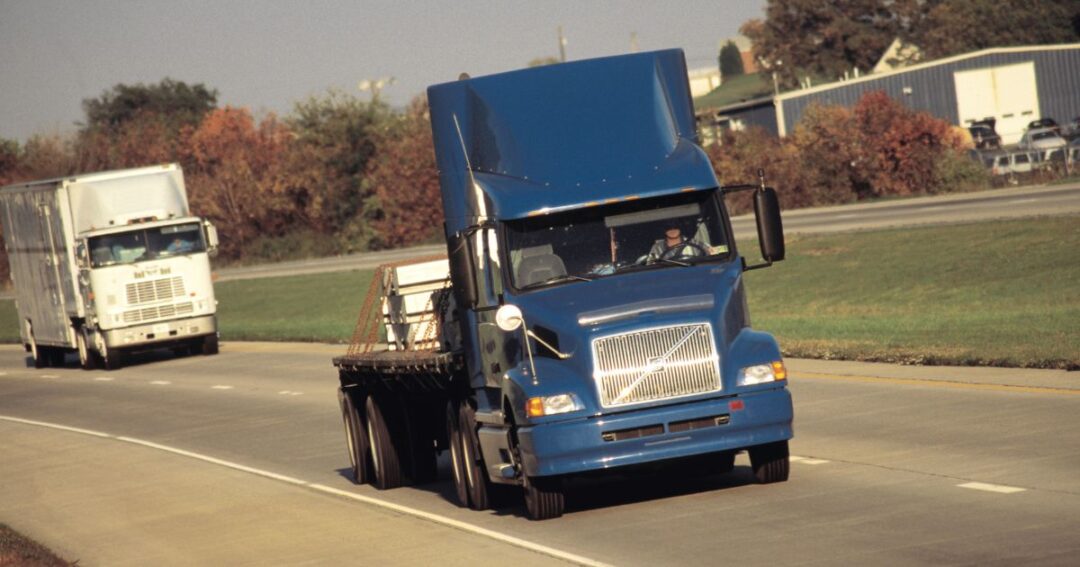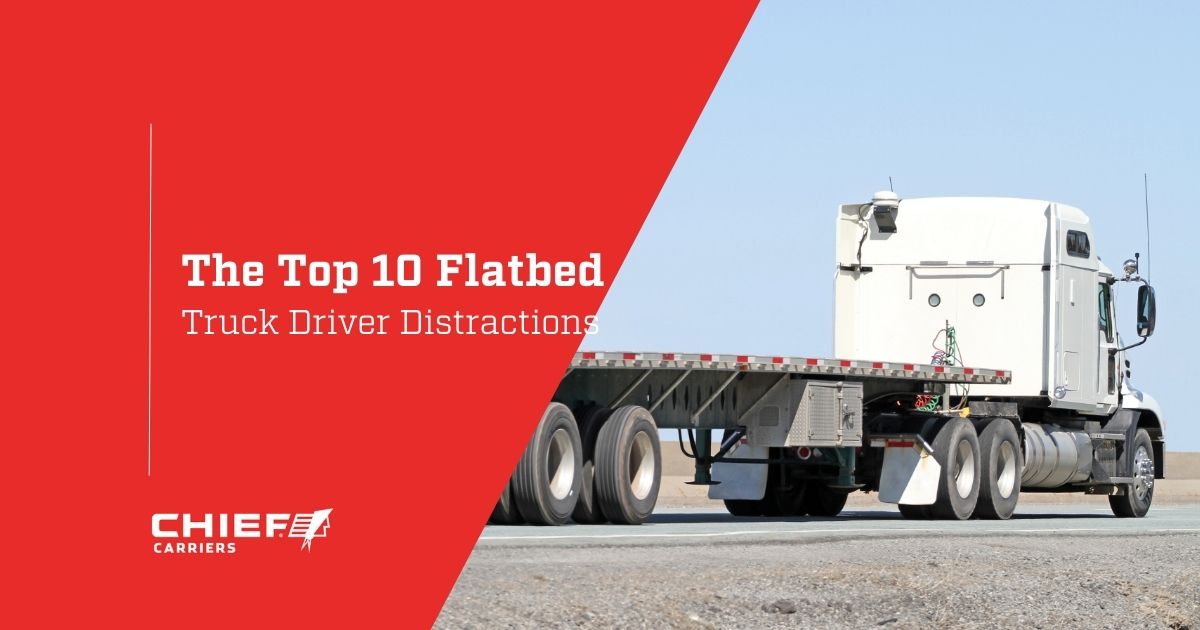Avoid Truck Driver Distractions and Stay Safe on the Road
Driving a flatbed truck demands constant attention. A momentary lapse in concentration is all it takes to transform a routine haul into a dangerous situation. Truck driver distractions can have severe – even fatal – consequences for the truck driver and other motorists sharing the road.
At Chief Carriers, we understand the dedication and skill it takes to be a professional flatbed driver. As an industry leader in flatbed trucking, we recognize the numerous truck driver distractions that can compromise commercial driver safety. We’ll explore the top 10 driving distractions that flatbed drivers commonly encounter and provide actionable strategies to avoid them and keep everyone safe on the road.

Understanding the Risks: Why Truck Driver Distraction Matters
Studies consistently show that a significant percentage of commercial vehicle accidents involve some form of driver distraction. When a truck driver’s attention is diverted from the road, the risk of accidents, including serious flatbed truck accidents, skyrockets. These incidents can lead to severe injuries or even fatalities that leave a lasting impact on individuals, families, and communities.
Beyond the immediate physical harm, truck driver distractions can also result in significant legal and financial repercussions. Drivers may face citations, fines, and even the suspension or revocation of their Commercial Driver’s License (CDL). Trucking companies can incur substantial costs related to accidents, including vehicle repairs, insurance premiums, and potential lawsuits.
Additional Factors Impacting Flatbed Truck Driving
Flatbed drivers face unique challenges that make heightened awareness even more important. The very nature of their cargo – often large, oddly shaped, or requiring specific securement – demands a constant evaluation of load shifts, bridge clearances, wide turns, road conditions, and potential hazards. It’s crucial to understand that even seemingly insignificant distractions can have devastating effects on the road, underscoring the need to avoid distracted driving..

The Top 10 Driving Distractions for Flatbed Truck Drivers
Truck drivers face many of the same driving distractions as passenger vehicle drivers, but their extended time on the road increases the likelihood of these incidents occurring. Some distractions, however, are unique to the truck driving profession.
Here are the top distractions for flatbed truck drivers, along with specific advice on how to avoid them:
1. Mobile Phone Use (Talking, Texting, Browsing)
Talking on a phone diverts cognitive focus, while texting and browsing cause visual and manual driving distractions by taking eyes and hands off the road. Although communication about loads and routes is crucial for flatbed drivers, the urgency of a message should never compromise safety.
How to avoid: Utilize hands-free devices responsibly for essential calls, but keep conversations brief. Pull over to a safe location to handle non-urgent communications. Silence notifications on your phone to avoid the temptation to check it while driving.
2. In-Cab Devices and Technology (GPS, Dispatch Systems, ELDs)
Constantly interacting with in-cab devices like GPS, dispatch systems, and ELDs, despite their efficiency aims, can divert a driver’s attention. Technology can add another layer of potential distraction to the already complex task of securing and transporting flatbed loads.
How to avoid: Program GPS and dispatch information before starting your drive. Utilize voice commands whenever possible. Plan your routes and familiarize yourself with your ELD system during off-duty hours.

3. Eating and Drinking
Eating and drinking are common driver distractions on long hauls as they require manual dexterity and divert focus from driving. Spills and dropping food can further lead to a loss of control, especially critical when handling flatbed cargo.
How to avoid: Schedule regular breaks in designated rest areas or truck stops to eat and drink. Secure food and beverages properly to prevent spills.
4. Adjusting Controls (Mirrors, Climate, Radio)
Flatbed drivers need to be constantly aware of their surroundings due to the often wider turning radius and potential overhang of their cargo. However, even brief glances away from the road to adjust mirrors, the temperature, or the radio can be dangerous, especially at highway speeds.
How to avoid: Make all necessary adjustments to mirrors, climate control, and the radio before you begin driving. If an adjustment is absolutely necessary while on the road, choose a safe moment with minimal traffic and make the adjustment quickly.
5. Fatigue and Drowsiness
Driving while fatigued impairs reaction time, judgment, and overall cognitive function, similar to the effects of alcohol, making it difficult to focus on the road and respond to unexpected situations. The demanding schedules and long hours often associated with flatbed trucking can lead to chronic fatigue, making drivers more susceptible to driving distractions.
How to avoid: Adhere strictly to hours-of-service regulations. Take regular breaks, even if you don’t feel overly tired. Recognize the signs of fatigue (e.g., frequent yawning, heavy eyelids, difficulty focusing) and pull over to a safe location to rest.

6. External Distractions (Roadside Events, Scenery)
Accidents, construction zones, or unusual scenery can tempt drivers to look away from the road ahead, potentially causing significant delays and increasing the risk of secondary accidents. Because the size and weight of a flatbed truck require a greater stopping distance and more careful maneuvering, any diversion of attention can have serious consequences.
How to avoid: Train yourself to focus on your driving path and avoid fixating on external events. Maintain a safe following distance to allow for unexpected stops caused by others’ distractions.
7. Emotional Distress and Mental Distractions
The life of a flatbed driver can be demanding and isolating, contributing to emotional distress and mental distractions. When a driver is preoccupied with personal issues, financial worries, or job-related stress, their focus is diverted from driving.
How to avoid: Practice stress management techniques during off-duty time and address personal issues when you are not behind the wheel. Utilize available support systems, such as employee assistance programs or talking to family and friends.

8. Interacting with Passengers
The responsibility of safely operating a flatbed truck requires the driver’s full attention. Engaging in lively conversations or dealing with passenger needs can take a driver’s focus away from the critical task of operating a large commercial vehicle.
How to avoid: Limit non-essential conversations while driving. If you need to address a passenger’s needs, choose a safe time and location to pull over.
9. Dealing with Paperwork and Logistics
Attempting to read, fill out, or organize paperwork while operating a vehicle is a significant risk. While important, dealing with load-related documents should never compromise driving safety.
How to avoid: Complete all necessary paperwork during scheduled breaks or before and after your driving shifts. Secure all documents to prevent them from moving around the cab and becoming a further distraction.
10. Personal Grooming
Engaging in personal grooming activities while driving takes both visual and manual attention away from the road—even seemingly quick grooming tasks can have dangerous consequences.
How to avoid: Take care of all personal grooming outside of driving time, during breaks, or before starting your trip.
Taking a proactive approach to avoid distracted driving is crucial for your safety and that of everyone else on the road.

The Role of Commercial Driver Safety in Preventing Flatbed Truck Accidents
Promoting commercial driver safety is a shared responsibility between drivers and trucking companies. Companies play a crucial role in establishing distracted driving policies, providing comprehensive safety training programs, and utilizing technology to mitigate truck driver distraction. In-cab camera systems, for example, can provide valuable insights into driving behaviors and help identify areas for improvement.
Chief Carriers demonstrates a strong commitment to driver and public safety through our award-winning Red Hat and Safety 360 programs. These initiatives emphasize continuous training, risk management, and cultivating a safety-conscious culture. The effectiveness of these programs is evident in the measurable improvements in our driver safety ratings and incident report statistics, which reflect our goal of safe driving in every community we operate in.

Prioritizing Focus for a Safer Journey
Truck driver distraction poses a significant threat to safety for themselves and all road users. By implementing these practical tips for staying focused as a flatbed driver, commercial drivers can significantly reduce their risk of accidents and contribute to safer journeys for everyone sharing the road.
As a leader in the flatbed trucking industry, Chief Carriers is dedicated to equipping our drivers with the knowledge and resources they need to operate safely and responsibly. Our safety training, which includes distracted driving, ensures that every mile driven by our drivers is a testament to professionalism and a commitment to safety.
If you’re a truck driver looking for a company that puts your safety first, contact Chief Carriers about commercial truck driving opportunities.

